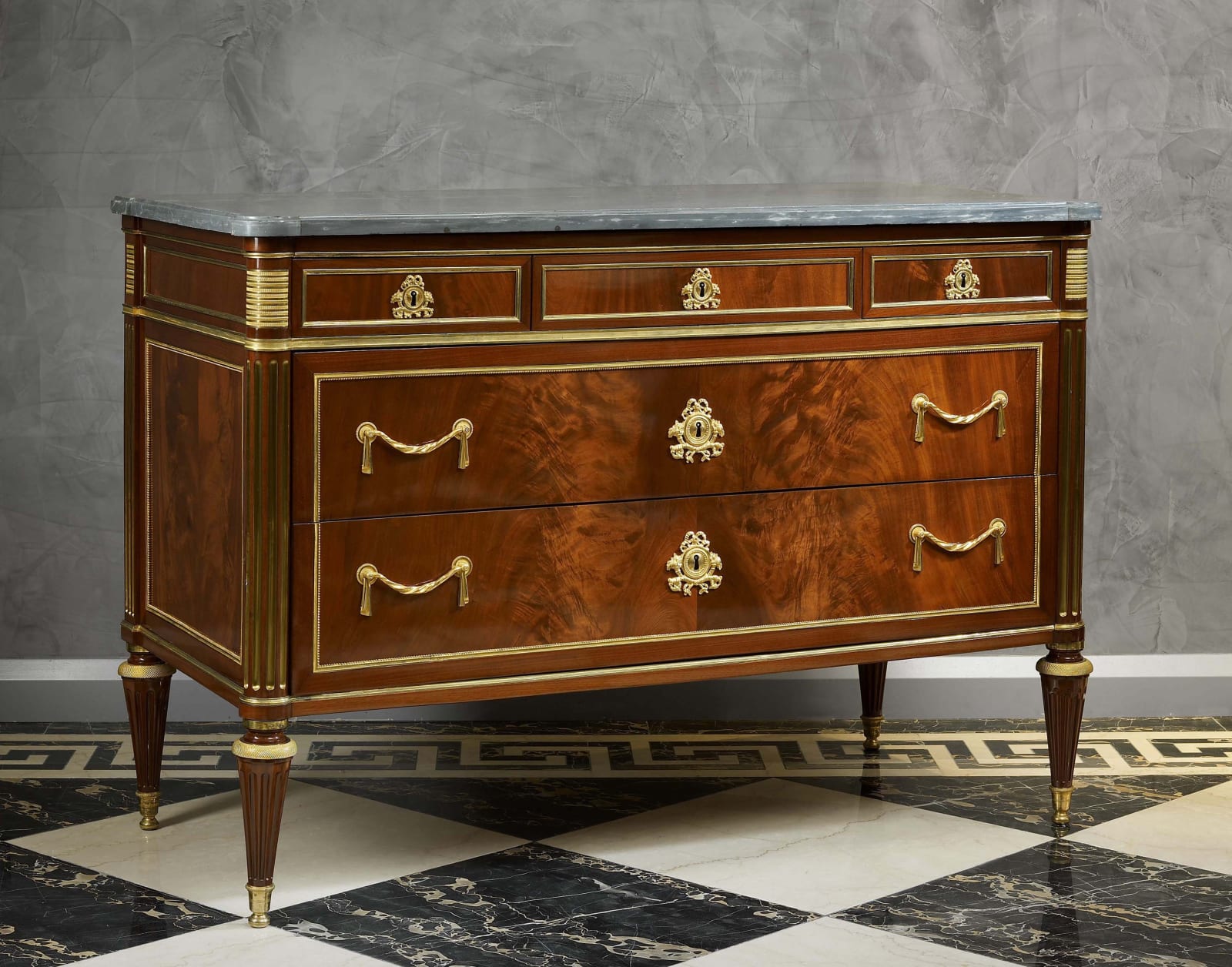Guillaume Benneman (attributed to)
An extremely fine Louis XVI gilt bronze mounted mahogany commode attributed to Guillaume Benneman, the moulded rectangular bleu turquin marble top with rounded corners above three short gilt edged frieze drawers with ribbon-tied foliate escutcheons above two long drawers within a gilt border, each with corresponding escutcheons and rope hanging pulls, the angles headed by banded gilt panels above gilt fluted columns on gilt banded toupie feet
Paris, date circa 1790
Height 92 cm, width 131 cm, depth 61.5 cm.
This superb commode shares a number of characteristics common to the work of Guillaume Benneman (also referred to as Beneman). First and foremost it is very similar to another of his mahogany commodes, illustrated in Pierre Kjellberg, "Le Mobilier Français de XVIIIe Siècle", 1989, p. 57, pl. B, the main difference being that the latter is break-fronted and has three separate panels of gilt banding on the lower drawers; the pulls also differ but the escutcheons are identical, as are the decorations to the angles, the columns and feet. Another almost identical commode stamped twice with the maker's mark is also known. Although it is difficult to categorise an exact Benneman style, as it was so diverse, many of his pieces featured the same elements as here, namely the use of well-figured mahogany veneers, refined gilt bronze mounts, panelling, banding and an overall architectural design. To this extent this piece can also be compared with a commode in the Musée du Louvre of 1787 made for Mme Thierry de Ville d'Avray, which has the same overall architectural form and gilt banding but also includes more abundant mounts made by Pierre-Philippe Thomire and Etienne-Jean Forestier.
Although his birth date is unrecorded it is known that Benneman was born and trained in Germany. He then moved to Paris and working independently in the rue du Faubourg Saint-Antoine he received his first royal commissions in 1784. The following year he was made a maître-ébéniste and was also appointed ébéniste de la Couronne. Finding himself in the enviable position as a replacement to Riesener, he worked almost exclusively for the crown, firstly under Jean Hauré until 1788 and then under Thierry de Ville d'Avray. The Crown officials gave him sufficient money to provide tools for nine craftsmen and by 1788 he had some twenty assistants As principal ébéniste to Louis XVI he worked on many pieces for Versailles, Fontainebleau, Saint-Cloud and other royal palaces. Among royal commissions he made a number of alterations and reconstructions of earlier pieces including some by Joseph Stöckel, as well as other pieces such as Louis XV's bureau at Choisy attributed to B.V.R.B. Other orders included replicas of earlier pieces such as a copy of a Riesener commode for Marie-Antoinette's bedchamber at Versailles.
Although he never mastered the French language Benneman's native birth and training was to his advantage. French royalty and aristocracy had long admired other German-born ébénistes such as J-F. Oeben, M. Carlin, A. Weisweiler and J-H. Riesener, whom Benneman replaced as the Crown's chief ébéniste. Benneman also supplied the nobility and aristocracy but then during the Revolution was employed by the new Republican government to remove 'insignia of feudality' from existing royal pieces. Toward the end of the 1780's Benneman moved to 6 Rue Forest, where he was still working when he rose to fame once more under Napoleon, providing the latter with a number of fine pieces. The most notable were a beautiful commode and secrétaire for Château Fontainebleau, designed by Charles Percier (1764-1838).
Today Benneman's work is prized among some of the finest collections of French furniture, notably at the Louvre, Paris; the J. Paul Getty Museum, Malibu; the Metropolitan Museum of Art, New York; the Hermitage, Leningrad; the Wallace Collection, London and Waddesdon Manor, Oxfordshire. Some pieces remain in private hands but they occasionally appear on the open market.
